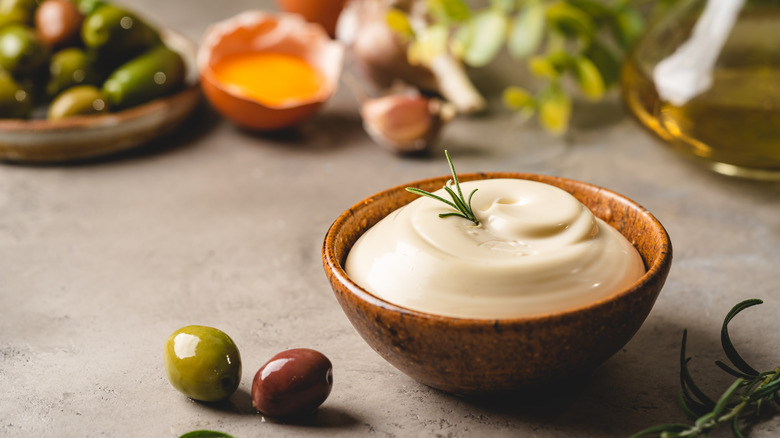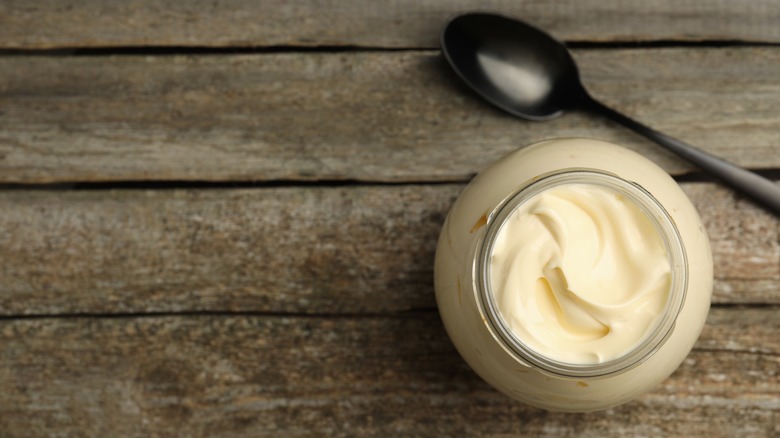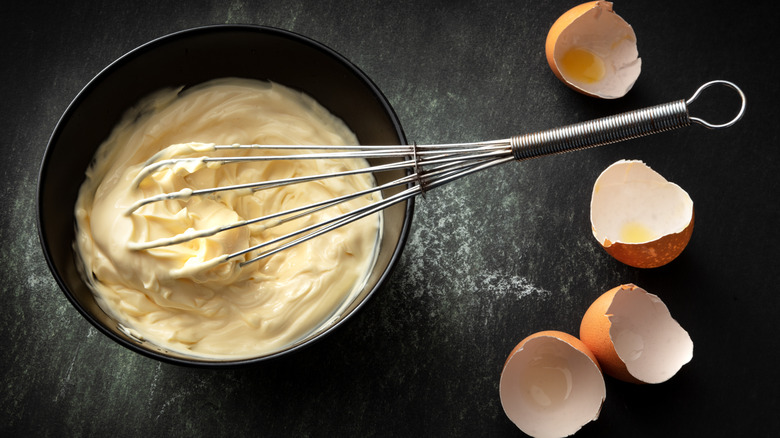Can And Should You Freeze Mayo?
You can throw almost any food into the freezer and be assured that it will stay perfectly fresh and edible for a long while. Left with a slice or two of bread? Stash it away in the freezer. Got one half of a cut-up avocado? Bag it up and pop it in the freezer. Just whisked a batch of homemade mayonnaise that you'd like to keep for longer than a few weeks? Into the freezer it goes ... but is that the best thing to do for it?
In terms of food safety, mayo can be safely frozen, defrosted, and eaten. Freezing can help mayo last up to three months, but that doesn't mean it will be the same when you thaw it. Mayo is a permanent emulsion, a stable and cohesive blend of water (from eggs and vinegar) and oil. Water and oil famously do not mix well, unless there is an emulsifier in the mix (like egg yolks) and/or you mix them vigorously enough to bind them.
Because of this delicate balance of ingredients, emulsions can be volatile. While freezing will extend mayo's shelf life, it will also throw the emulsion of oil and water off-balance when it thaws. Though thawed mayo is safe and edible, its smooth, thick, and luscious texture can separate into a grainy and curdled one. Who wants that in their sandwiches and potato salad? However, if you really want to try freezing mayo, there are ways to ensure a better outcome.
The best way to freeze mayo
If you're willing to compromise on the texture of your mayonnaise, you should learn the best way to freeze it. The first thing to note though is that the fresher the mayo, the smaller its chances of separating when it thaws. Freeze your mayo as soon as you make it, or right after you unscrew the lid, if it's store-bought.
The best containers for freezing homemade mayo are sterilized, freezer-safe glass jars. Once you've transferred the mayo into the jar, pour a spoonful of either vinegar or lemon juice on top and gently whisk it in. Although mayo already has some acid in it, a little extra can be the difference between slightly separated mayo and one that looks like lumpy spoiled milk. Acid can help to stabilize the mayo when it's in the freezer and when you defrost it.
Mayo also has a tendency to expand in the freezer, so always leave a tiny bit of room for it to swell up in the jar. The last factor to be aware of is contamination. Always use clean cutlery to scoop mayo into its freezer-shaped jar, and also for scooping it out. Never, ever double-dip into the jar with a utensil that's been in your mouth. Keeping germs out of the condiment helps it last its longest.
How to improve thawed mayo
When it's time to use the frozen mayo, it's essential to thaw it properly first. Leaving frozen foods on the counter to defrost or microwaving them may be the usual status quo, but neither of those methods should be used with frozen mayo. Instead, take out as much mayo as you need and place it in the refrigerator overnight. You want to avoid freezing, thawing, and re-freezing it, which will make its texture rapidly deteriorate.
Once defrosted, you'll notice a layer of liquid floating on the top of your mayo. There are a few ways to mix this liquid back into the condiment. One way is to simply discard the extra liquid and stir the rest of the sauce thoroughly before using it. Alternatively, you could re-emulsify defrosted mayo by blending it on high speed for a brief time, adding a splash of water if it needs the extra help to turn smooth again.
Another trick is to whisk the mayo little by little into a separate bowl with an egg yolk. The extra yolk will help re-emulsify the split mayo until it looks rich and velvety again. Thawed mayo will likely never be exactly the same as it was before you froze it, but using best practices and a little elbow grease can help you successfully freeze and thaw it, instead of throwing it away.



